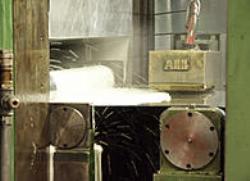Jun 3 2010
The rugged AP300 pH/Redox sensors that are capable of functioning up to 6 bar and 105 „aC have incorporate temperature compensation, measurement and reference components in to a single unit. The sensor is available in different variations like in-flow through and dip type immersion to provide users with ability for covering the broadest possible application range.
 ABB Sensors for rolling mills
ABB Sensors for rolling mills
The AP300 range has five models. The AP301, a locknut-style PVDF, in-line/immersion, sensor, can be transformed for dip-type immersion also. The PVDF made AP303 and AP302 can also be transformed to dip or immersion. It is possible to install, commission and maintain the totally-retractable AP305 and AP304 sensors with PVDF-bodies without requiring a costly bypass system. This helps to reduce the cost of new projects and enables the sensors to be maintained without shutting down the process.
The sensor is positioned at the tip of the AP300¡¦s tip along with reference and measuring electrodes. The sensor delivers accurate data that can be utilized for compensating the temperature effects for offering a precise pH measurement. The plug seal technology of ABB, which lowers the thermal stresses present inside the glass electrode that is pH-sensitive, increases the protection level further.
This technique replaces the method of glass melting during production for holding the inner wire of the element in position, which can impact the glass¡¦ strength. The integrator temperature compensator in the AP300 provides enhanced speed and accuracy of response. Using the three-wire PT100 as a standard boosts the confidence of users in the AP300¡¦s temperature readings¡¦ accuracy, irrespective of the cable runs length. The AP300 range is sold with the available standard ABB pH-sensitive glass or the low-resistance glass option, for speeding up the sensor¡¦s response by an order of scale at temperatures below 15 „aC.
The standard glass of ABB provides a much reduced sodium error as against competing gadgets that helps the sensor in maintaining its accuracy at high pH levels, more so at a time when readings would have been drifted due to sodium ions.
The media-resistant gel electrode is enclosed in a sturdy outer casing. The gel faces the PTFE liquid junction and is particularly fouling resistant when used along with a flat glass component. The AP300 has a double-junction construction for maximum safeguard against poisoning of the electrode element. The reference electrode is protected in two ways for extending the sensor life. The diffusion path length between the electrode and the PTFE interface is doubled resulting in longer time for the sample¡¦s poisoning ions to travel the distance. The reference gel¡¦s movement around the electrode is prevented by incorporating it in a pocket.